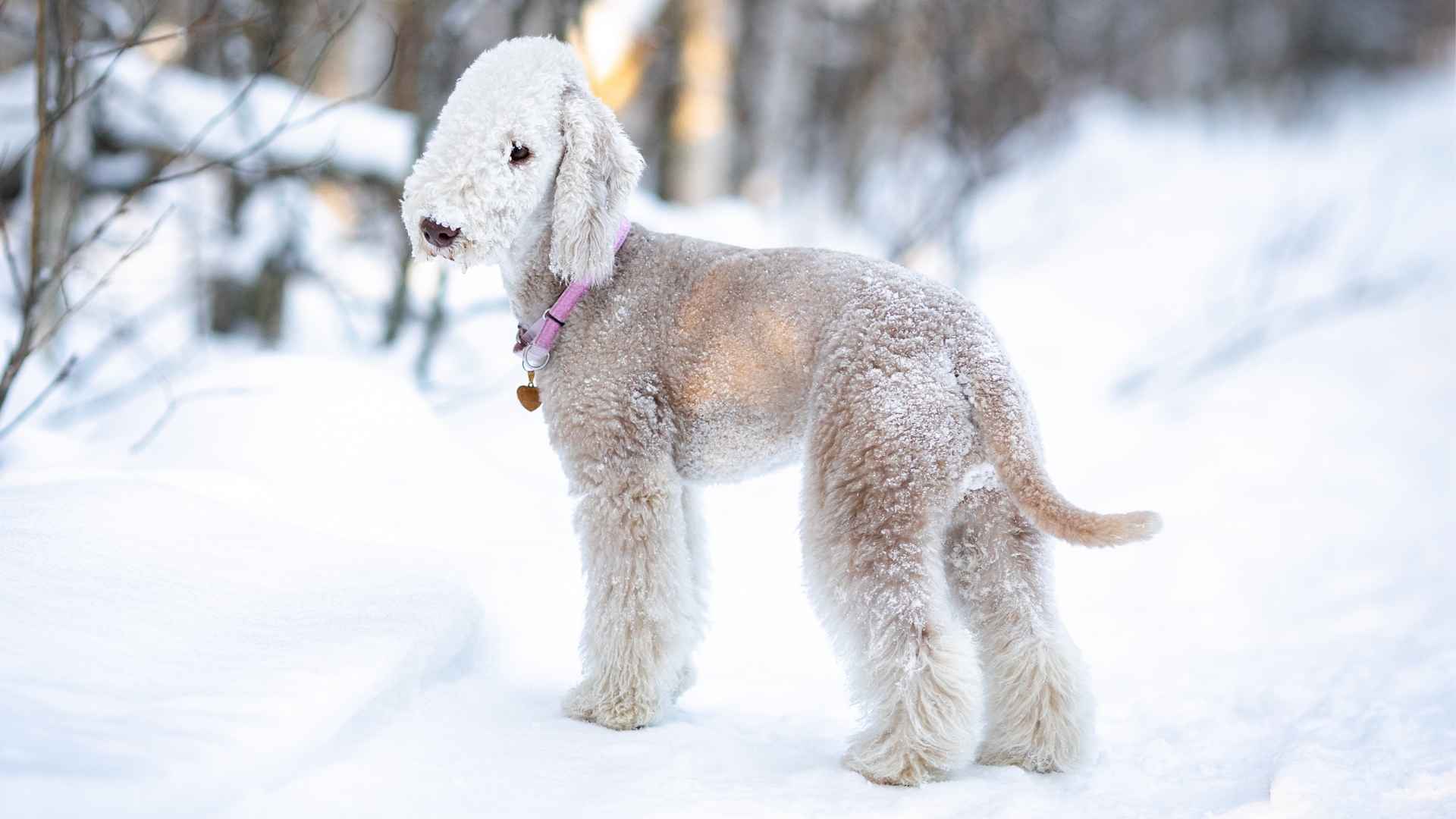Some dogs are so uniquely shaped, boldly colored, or irresistibly expressive that they look like they’ve stepped straight out of an animated movie. Their oversized ears, exaggerated proportions, or uncanny facial expressions make them feel less like real animals and more like sidekicks in a Saturday morning cartoon.
While most of us are familiar with classic cartoonish breeds like the French Bulldog or the Shih Tzu, there’s a whole world of rare dog breeds with an equally whimsical appearance, just far less likely to be spotted at the dog park.
In this guide, we spotlight some of the rarest dog breeds that boast cartoonish looks: squishy faces, wild coats, long legs, or playful, oddball expressions that wouldn’t feel out of place in a Pixar scene.
These breeds aren’t just about looks; they often come with fascinating histories, quirky traits, and unique grooming or care needs. Whether it’s the mop-like coat of the Puli or the lanky strut of the Azawakh, these rare pups blend fantasy and function in unforgettable ways.
So if you’ve ever dreamed of owning a real-life cartoon dog, read on, as these rare breeds might just be your next obsession.
Rare Breeds That Look Like Cartoon Dogs
1. Bedlington Terrier
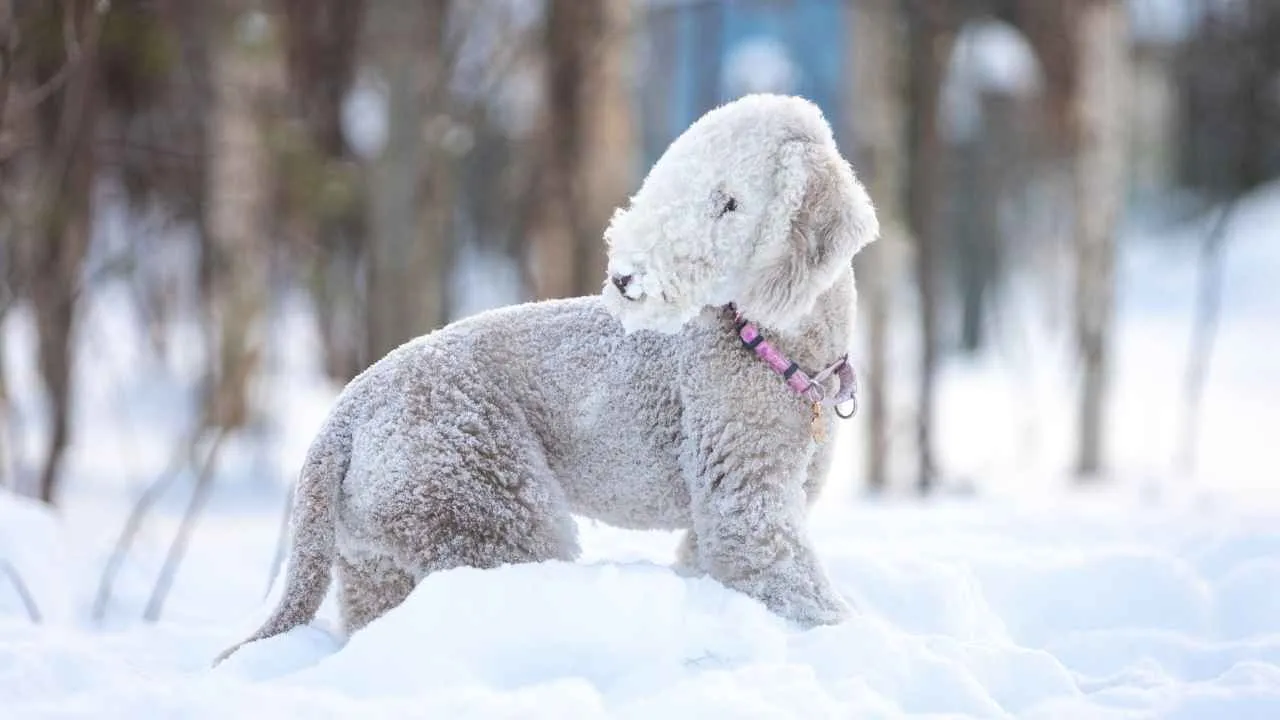
The Bedlington Terrier’s unusual silhouette, with its arched back and narrow, lamb-like face, sets it apart from every other breed. Its curly, lint-textured coat and tasseled ears give it a whimsical look that’s often compared to cartoon characters. But beneath that soft exterior is a tough, tenacious terrier built for agility and speed.
Originally bred for hunting vermin in Northern England, the Bedlington is energetic, fast, and surprisingly muscular. While they carry themselves with elegance, they were once competitive racing dogs and retain a strong prey drive. Their alertness also makes them reliable watchdogs, though they’re not known to be nuisance barkers.
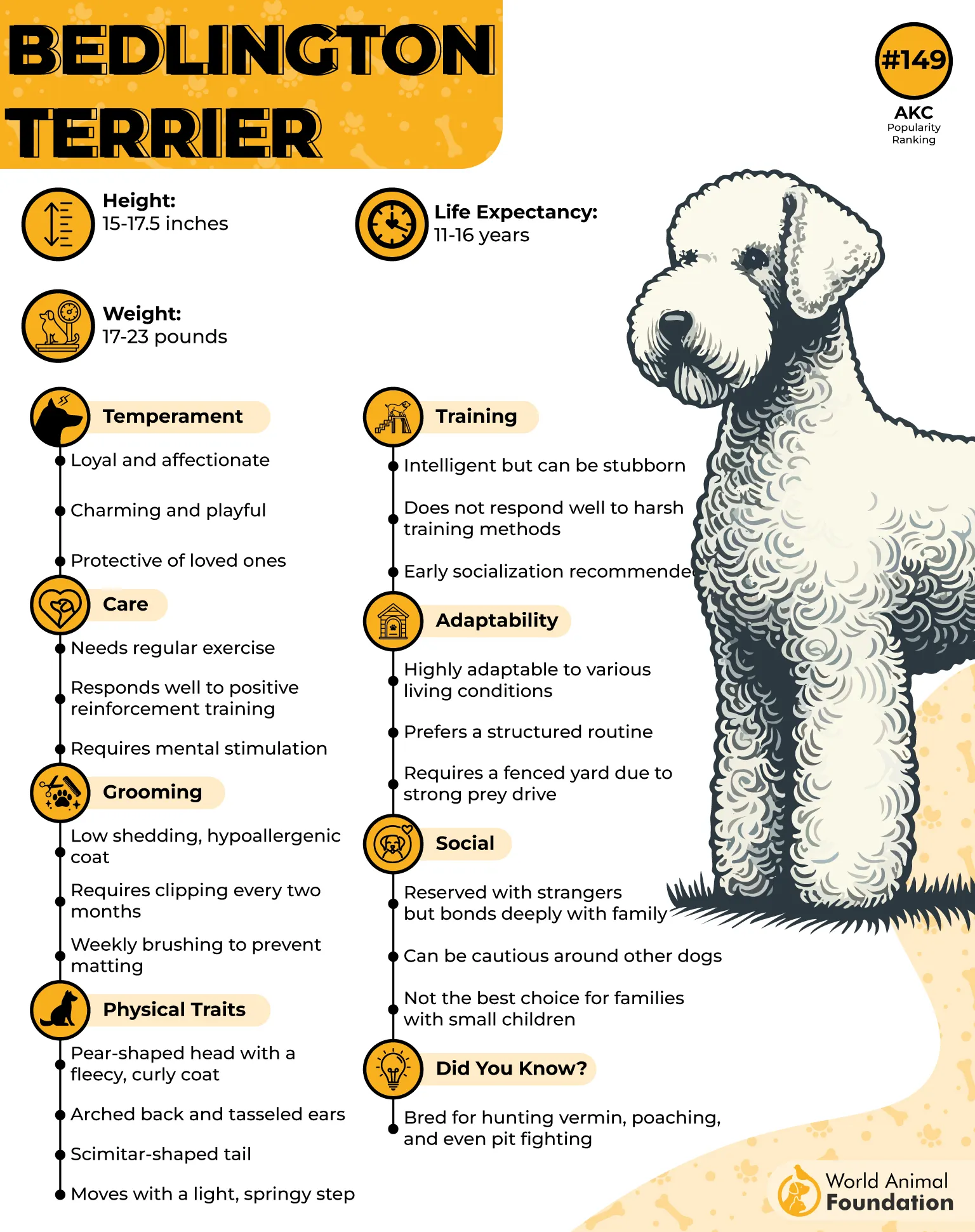
These terriers bond closely with their families and are often affectionate without being clingy. With early socialization, they do well with children and other pets, but their strong instincts may emerge around smaller animals. They tend to be polite but may display territorial behavior in unfamiliar situations.
Their coat requires professional grooming every few weeks to maintain shape and prevent matting. The unique texture doesn’t shed much, but brushing is essential to avoid the buildup of debris in the curls. Skin sensitivity can sometimes be a concern, especially around the ears and tail.
This breed is an ideal companion for owners looking for a combination of charm, athleticism, and individuality wrapped in one of the dog world’s most distinctive appearances.
Quick Tips
Best for homes with secure yards—strong chase instincts
Regular coat trimming every 6–8 weeks is essential
Early socialization improves adaptability and confidence
2. Pumi
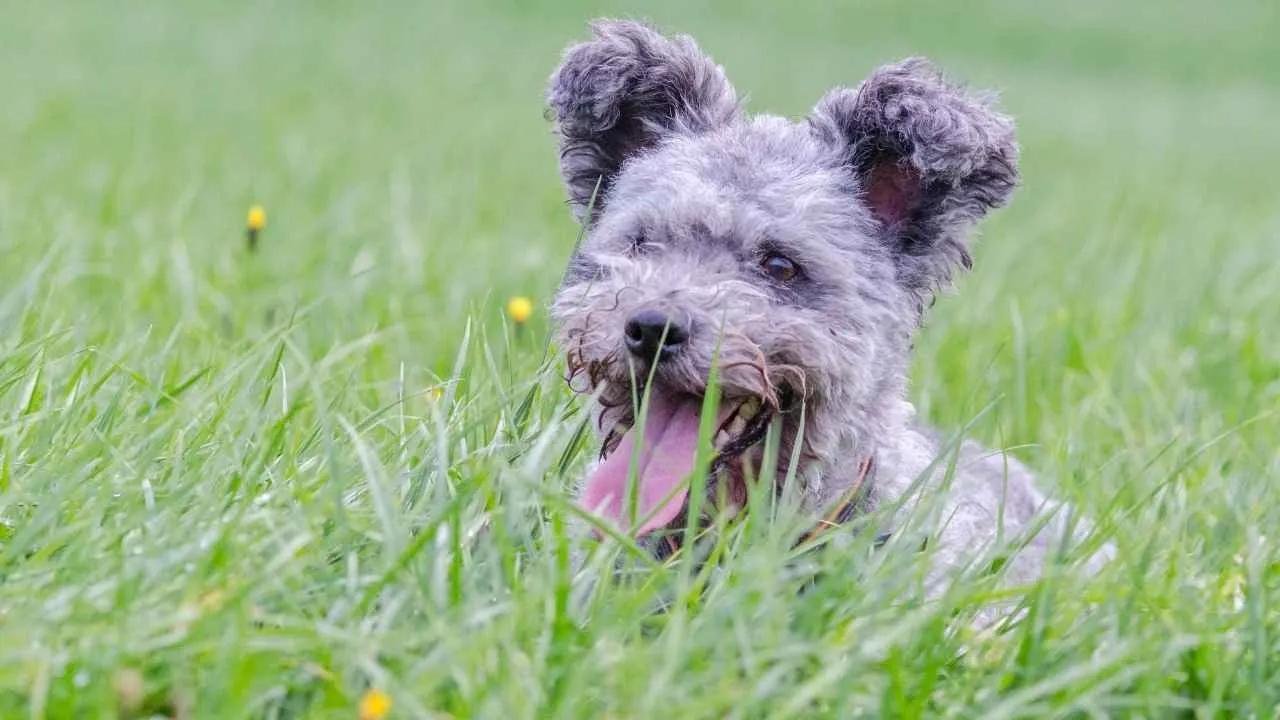
The Pumi is a compact herding breed from Hungary, instantly recognizable by its perky ears and tightly curled coat. The breed is expressive, full of personality, and known for an alert stance that makes it look ready to move at all times. With its cartoonish features and springy energy, the Pumi is both rare and visually striking.
Bred for herding livestock in challenging terrain, the Pumi is quick on its feet and quicker to think. It thrives in dynamic environments and needs mentally stimulating tasks. Herding behaviors may appear even in play, especially with kids or other pets, so training should begin early to channel that energy constructively.
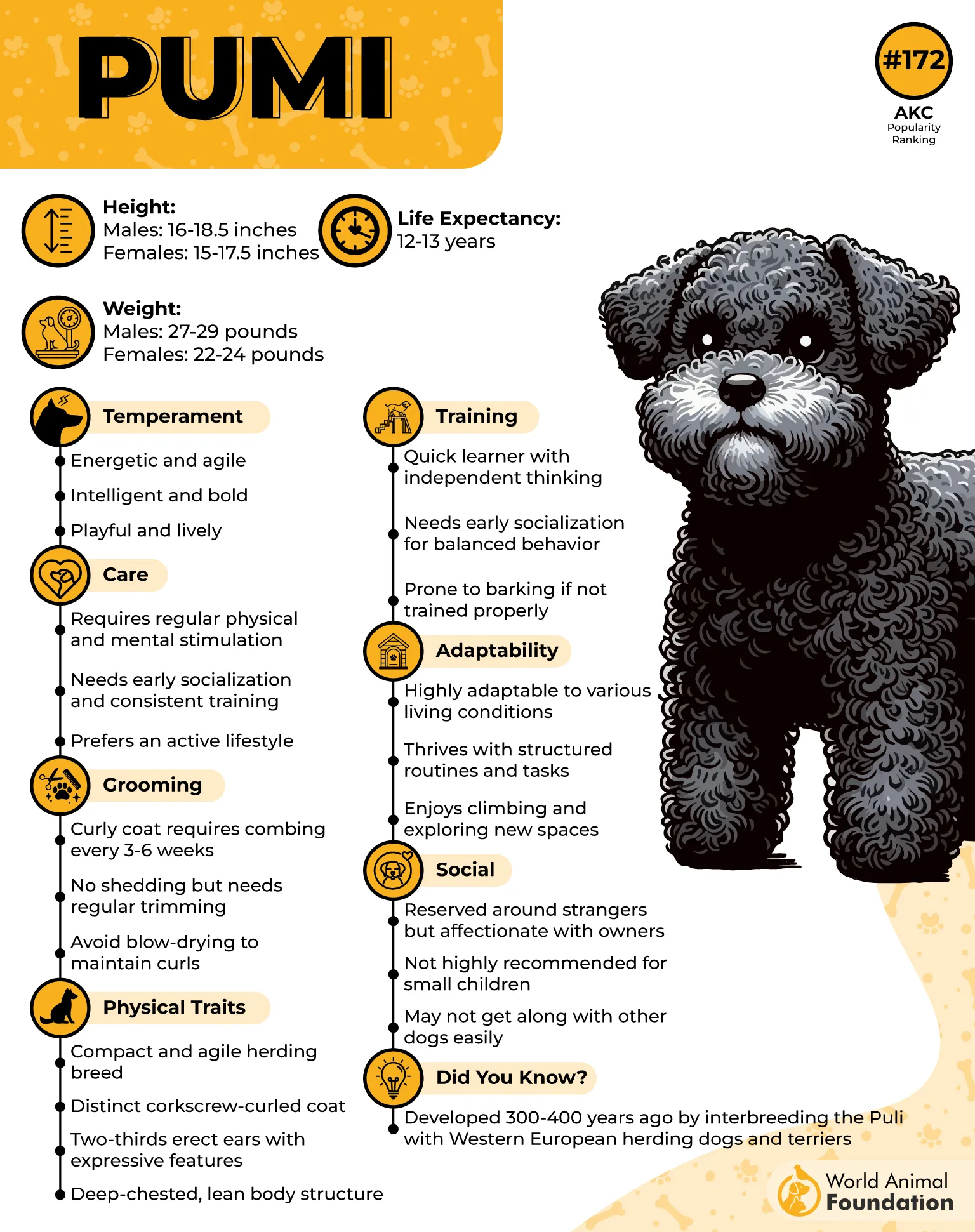
Though affectionate and loyal to its family, the Pumi can be reserved with strangers. It’s naturally vocal, often using a range of barks and chirps as part of its communication style. While not aggressive, it’s a breed that doesn’t shy away from announcing its opinions, especially when under-stimulated.
Its coat is a mix of harsh and soft hair, which forms loose curls that require regular brushing and occasional trimming. While the breed is considered low-shedding, it still demands maintenance to prevent matting and to maintain curl texture. The coat is weather-resistant and functional across seasons.
Quick Tips
High mental and physical stimulation needs
Naturally vocal, consistent training helps manage this
Best suited for confident handlers familiar with working breeds
3. Keeshond
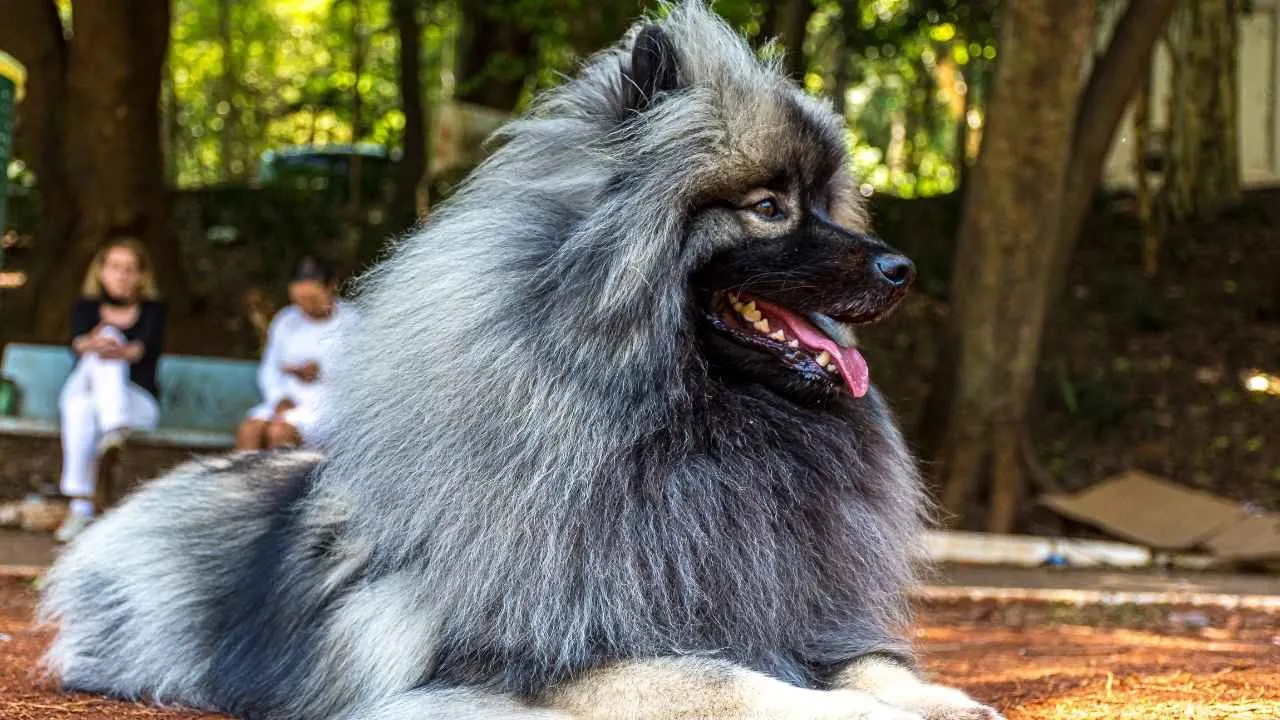
The Keeshond is a medium-sized companion dog with a voluminous double coat and a distinctive facial expression that resembles a perpetual smile. Its signature spectacles—markings and shading around the eyes—give it a cartoon-like charm and a lively, intelligent gaze. Despite its plush, showy coat, this breed was historically a barge watchdog in Holland, chosen for its alertness and sociability.
Keeshonden form deep attachments to their people and are known for their affectionate, family-oriented demeanor. They’re excellent with children and usually get along well with other pets. Their desire to stay close to their humans has earned them the nickname “Velcro dog,” and they thrive on companionship and attention.
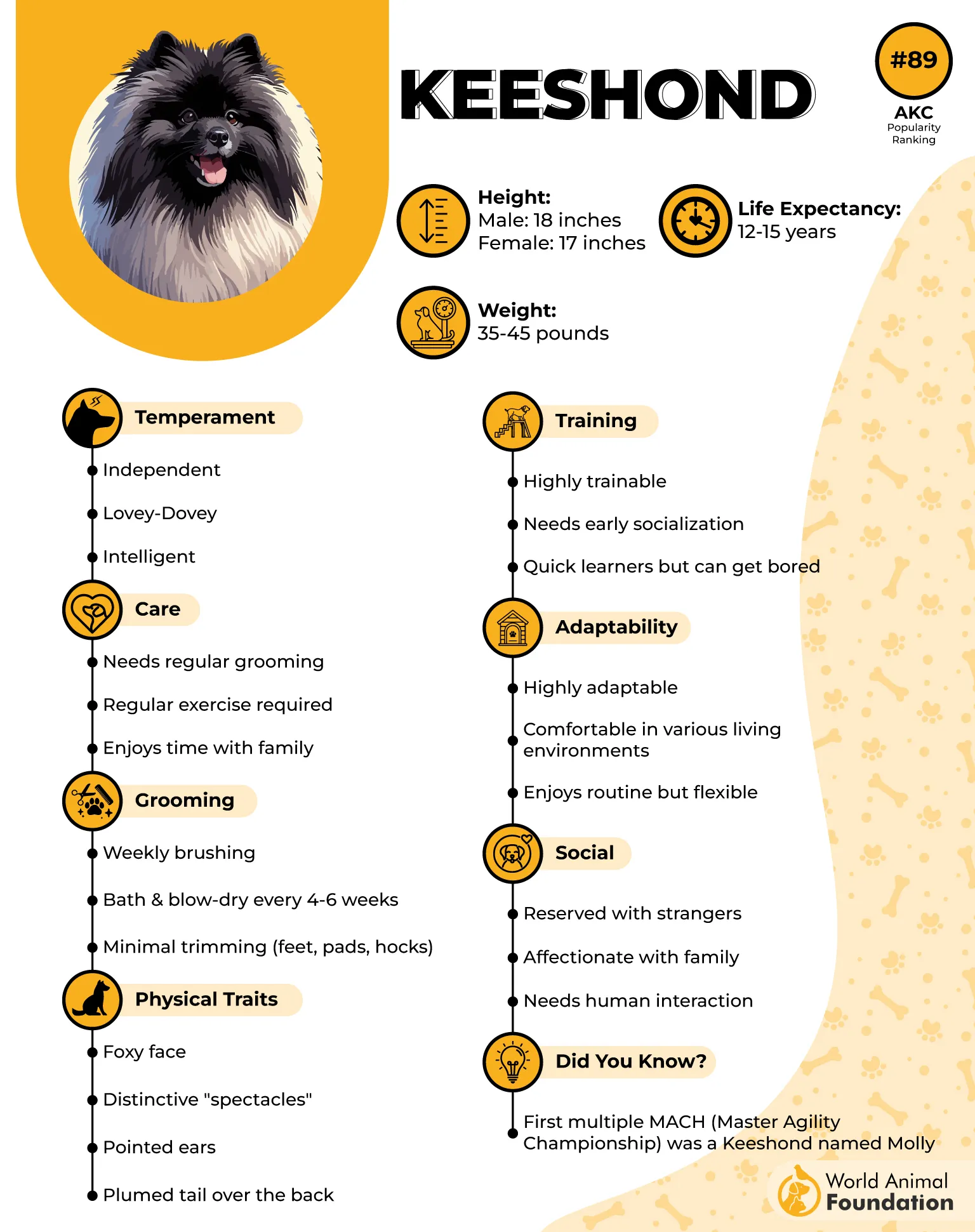
Although friendly and cheerful, they can be vocal, using their bark to alert the household to anything unusual. This makes them effective watchdogs, but early training is important to keep noise levels in check. Unlike many spitz breeds, the Keeshond is more people-pleasing and responsive to commands.
The thick coat demands regular care, with brushing needed at least twice a week to manage shedding and prevent mats. Despite its volume, the coat has a natural resistance to dirt and doesn’t require frequent bathing. Undercoat blowouts typically occur seasonally, requiring more intensive grooming sessions during those periods.
Quick Tips
Regular brushing prevents tangles and manages shedding
Craves companionship—avoid leaving them alone for long stretches
Early training helps curb over-alert barking
4. Eurasier
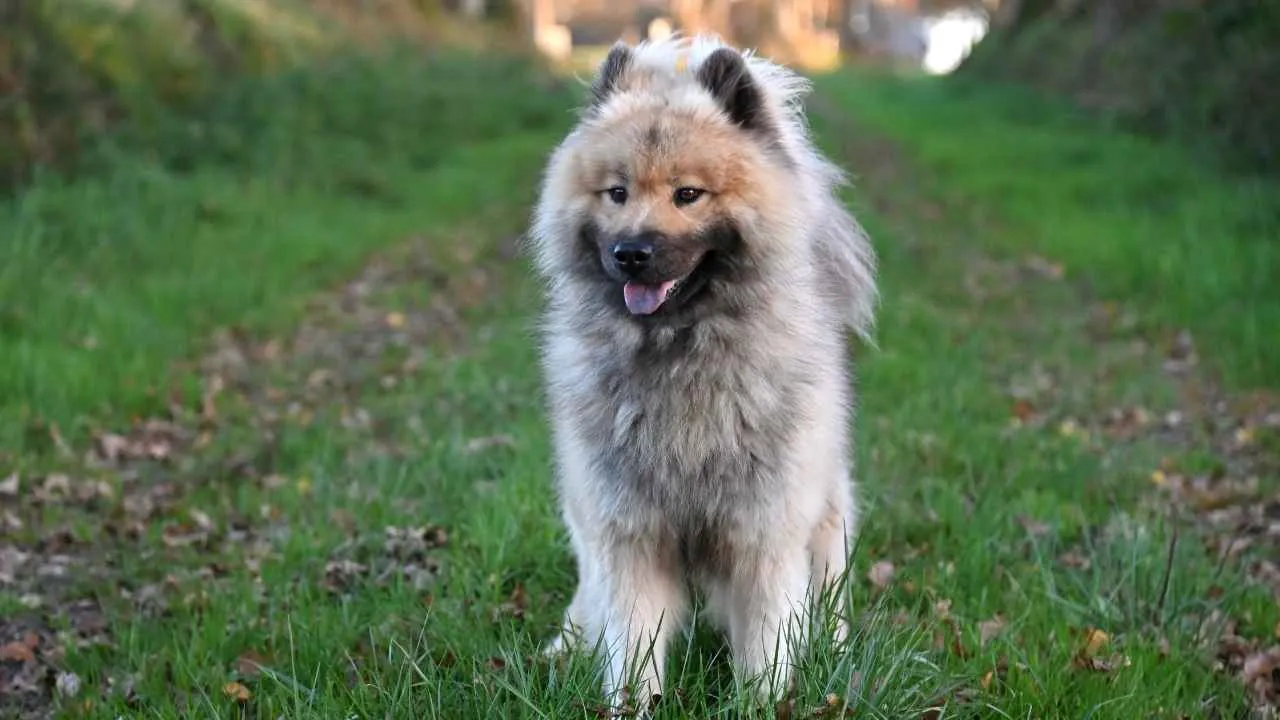
The Eurasier is a balanced, dignified breed developed in Germany by crossing the Chow Chow, Wolfspitz, and Samoyed. With its thick, fluffy coat and poised, soft expression, the Eurasier often draws comparisons to teddy bears and animated dogs. It was bred for temperament as much as appearance, with the goal of producing a calm and emotionally stable family companion.
This breed is reserved but not shy, often aloof with strangers, but deeply bonded to its inner circle. Eurasiers are watchful without being reactive, and they rarely bark without cause. Their steady demeanor makes them particularly suited to homes that prioritize calm and predictability over chaos or stimulation.
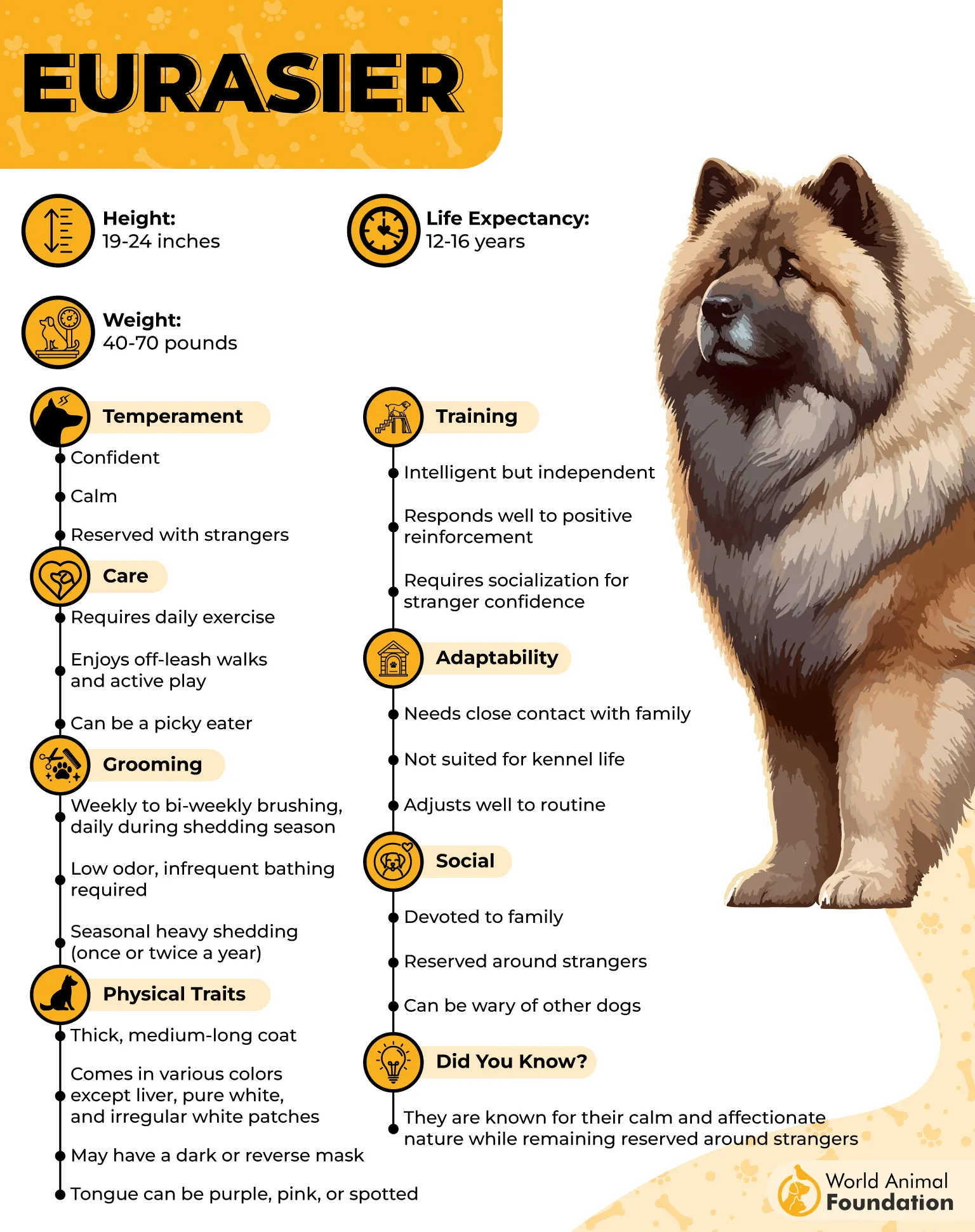
Eurasiers are intelligent and learn quickly, though their independent streak can appear during training. They respond best to gentle, consistent reinforcement and may resist coercive techniques. Their even temperament makes them ideal for families with older children or for adults seeking a loyal, quiet companion.
Coat care is essential; weekly brushing keeps the double coat free from tangles, and seasonal shedding will require more frequent grooming. Their coat offers excellent insulation, so they tolerate cold weather well, but care should be taken during warmer seasons to avoid overheating.
Eurasiers are ideal for families wanting a composed, affectionate dog that thrives on quiet companionship and stable routines rather than high-intensity play or overstimulation.
Quick Tips
Calm environment suits this breed best—avoid noisy, high-traffic settings
Socialize early to prevent excessive aloofness with strangers
Watch coat condition during seasonal sheds—double brushing may be needed
5. Lowchen
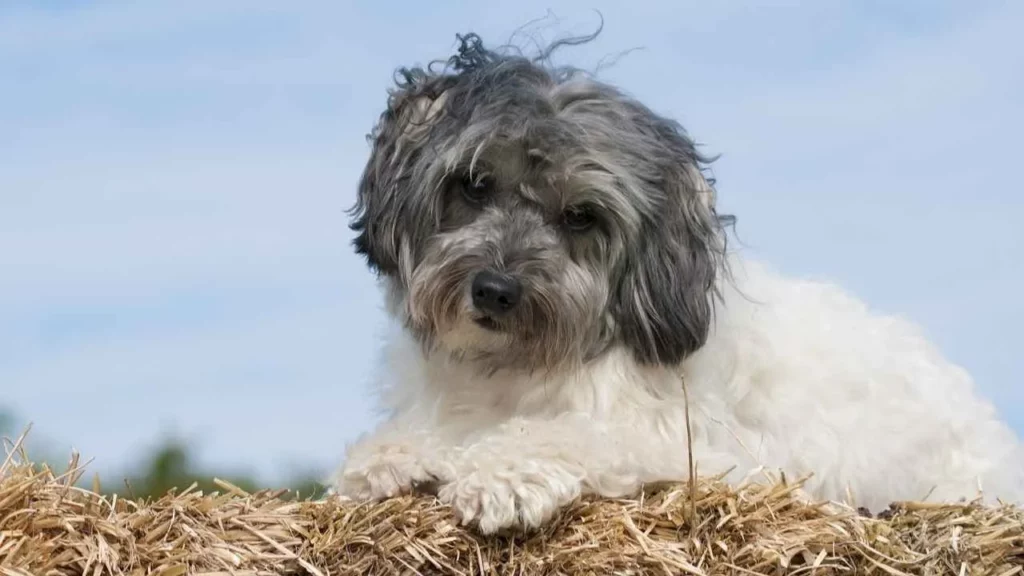
With a name meaning “little lion” in German, the Lowchen’s distinctive clipped coat and proud stance make it one of the most visually memorable toy breeds. Its cartoonish profile, a big mane, clean-shaven rump, and expressive eyes add to its quirky charm. But the Lowchen’s appeal goes far beyond appearances.
This breed was a favorite among European nobility, especially in France, where it was treasured as a lap companion and bed-warmer. It’s sturdy, playful, and remarkably well-balanced emotionally. As noted by Purina New Zealand, the Lowchen is an ideal pet for those seeking a rare, personable breed with a bold look and a gentle heart.
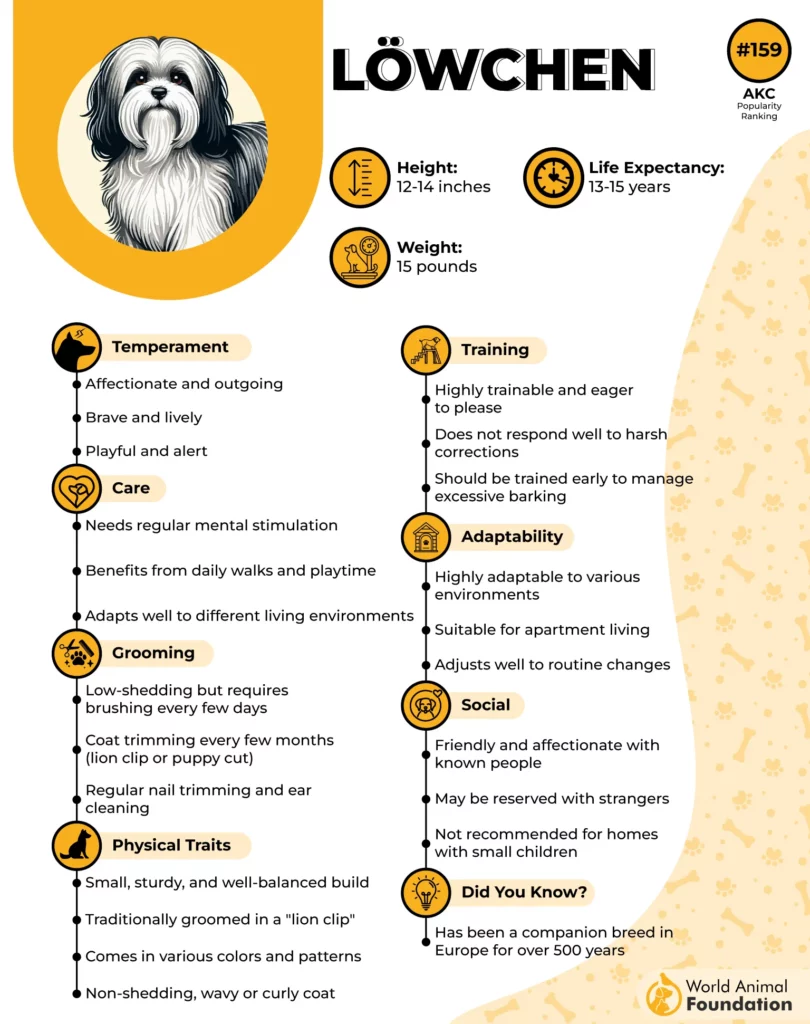
Lowchens are spirited and alert but not overly excitable. They enjoy engaging with their humans, whether through games or calm lounging. Their moderate energy levels make them easy to manage, and their intelligence ensures that training goes smoothly when approached with consistency and warmth.
The coat, though elaborate in appearance, is relatively easy to maintain. Regular brushing will prevent tangles, and professional grooming helps preserve the lion trim if desired.
Quick Tips
Groom every few days to maintain the signature lion clip
Thrives with light daily activity and indoor companionship
Great fit for families wanting an expressive and lively toy breed
6. Dandie Dinmont Terrier
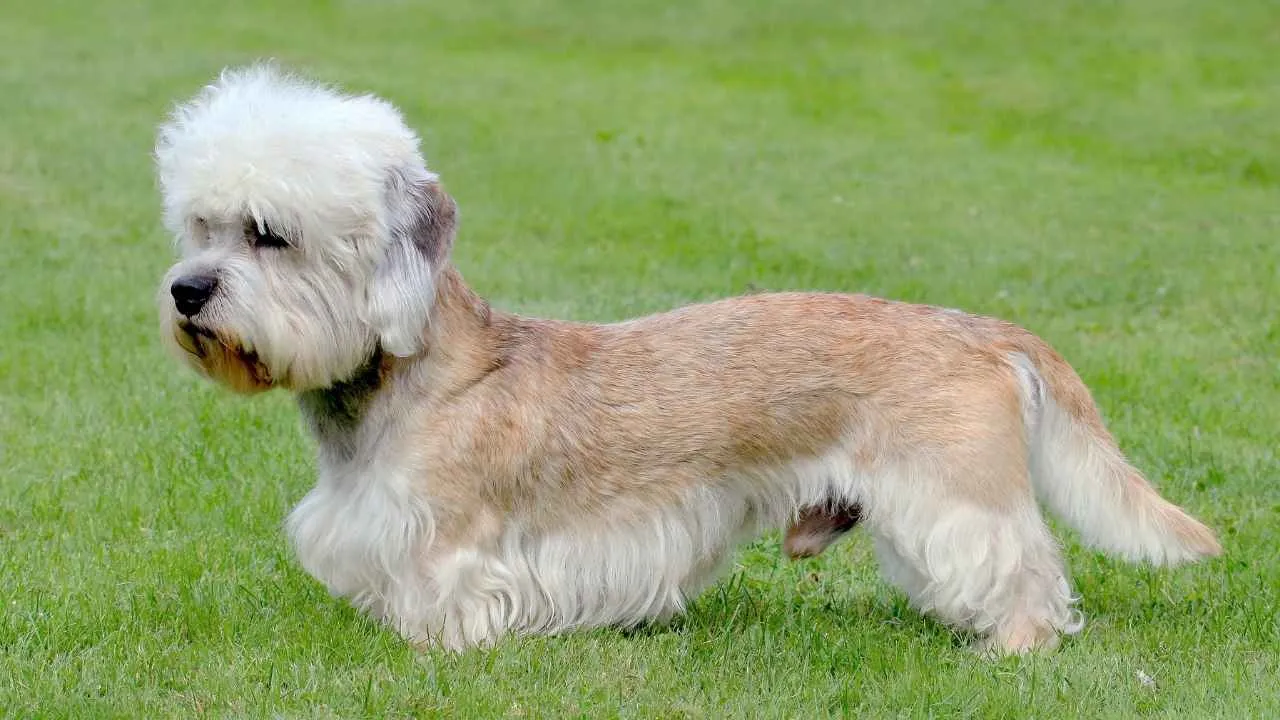
The Dandie Dinmont Terrier, with its elongated body, domed head, and oversized eyebrows, looks like it stepped out of a children’s book. It’s one of the rarest terrier breeds and one of the few to be named after a fictional character, Dandie Dinmont from Sir Walter Scott’s novel Guy Mannering.
Ditching the fiery disposition typical of many terriers, Dandies are steady and reserved. They’re confident but not confrontational, and their affectionate loyalty to family is unmatched. While wary of strangers, they seldom overreact, relying more on observation than aggression.
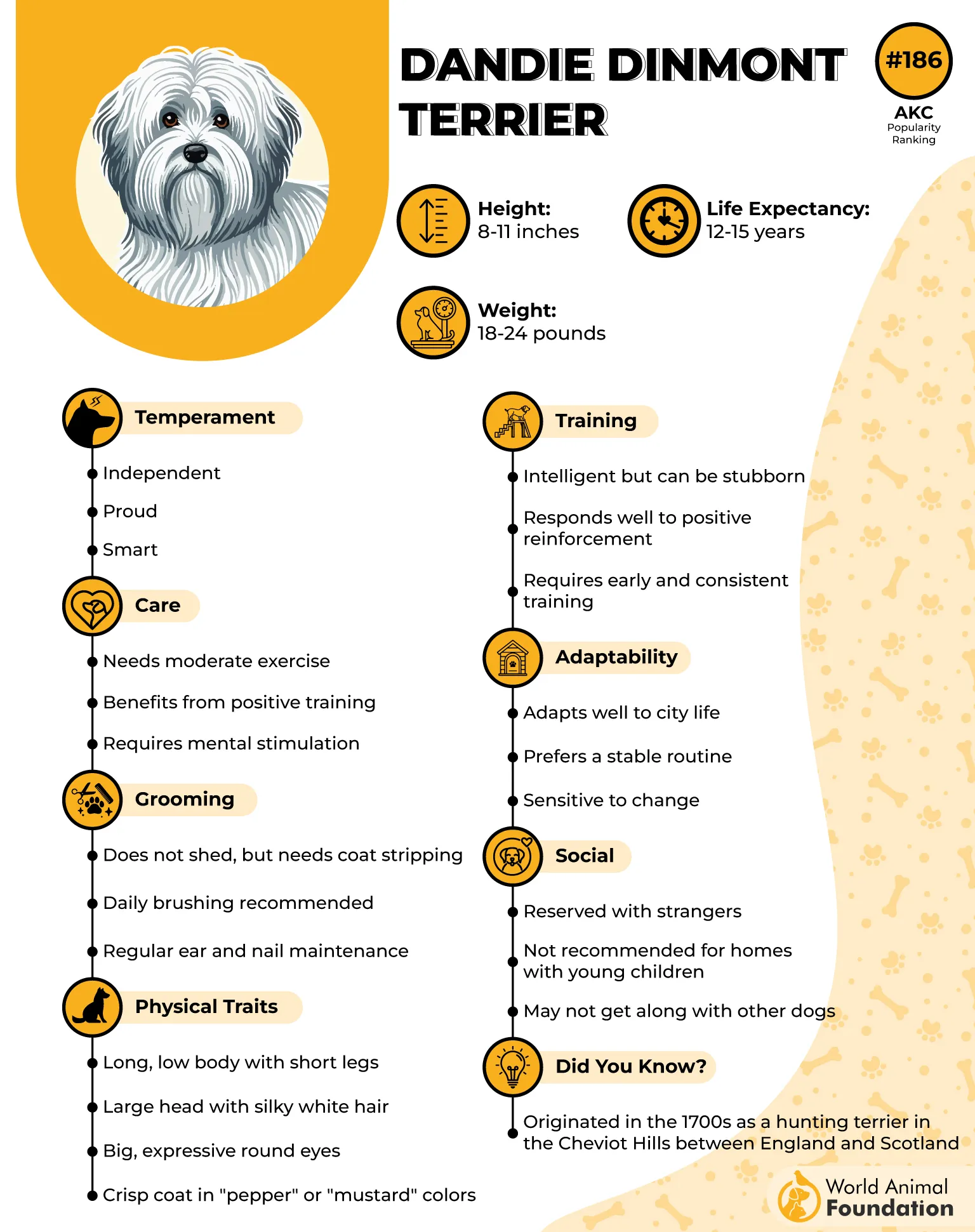
Their deep bark is often surprising given their size, but it adds to their watchdog credentials. Still, they prefer close contact with their humans over confrontational behavior. These terriers form deep bonds and are particularly sensitive to mood shifts in their home.
The coat, a mix of soft and harsh textures, requires routine grooming but not excessive styling. Weekly brushing and occasional hand-stripping or trimming keep them looking tidy. Their short legs and long backs mean care should be taken to prevent spinal strain, especially in homes with stairs.
Quick Tips
Avoid overexertion due to a long-backed structure
Brush weekly and trim seasonally to maintain the coat
Ideal for quiet homes seeking a devoted, mellow terrier
7. Sealyham Terrier
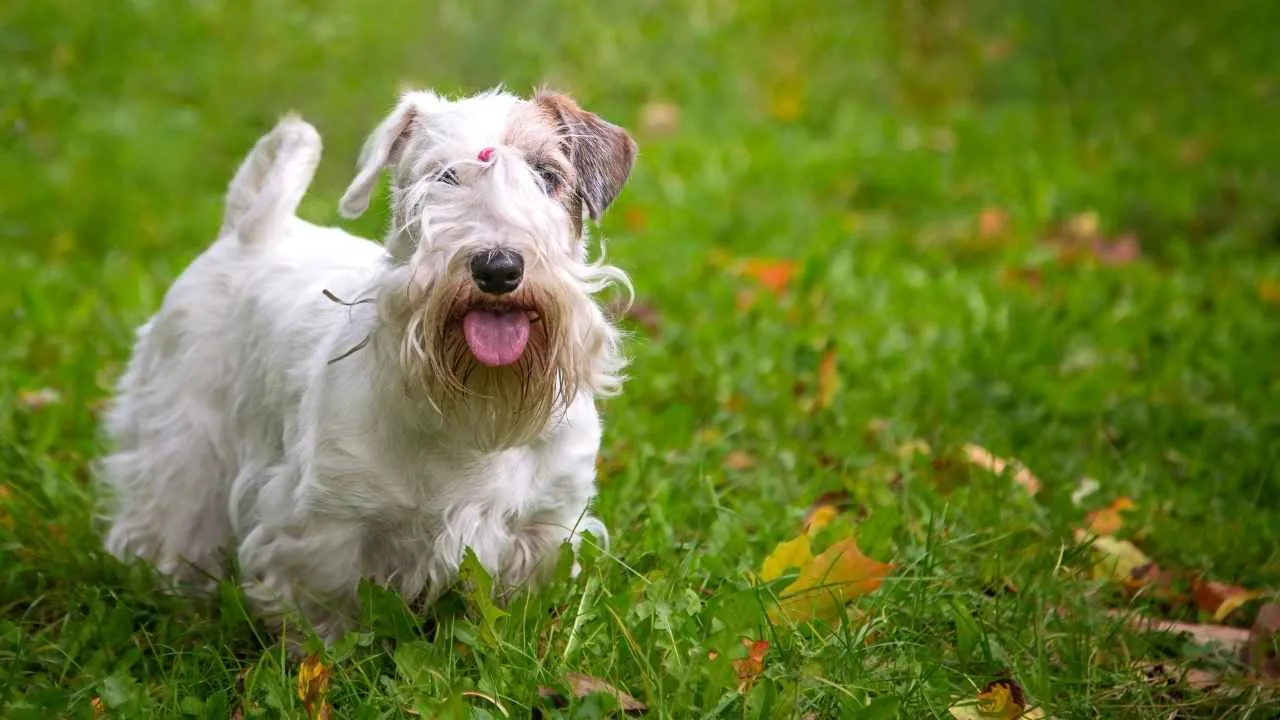
The Sealyham Terrier, developed in Wales for hunting small game, has a low-slung body, expressive brows, and a lush beard that gives it a cartoonish, dignified look. Its appearance is part old-school British gentleman, part animated sidekick, and entirely distinctive.
Though bred for boldness in the field, the modern Sealyham is calm and composed at home. It doesn’t bark without reason and rarely acts impulsively. This makes it a great candidate for apartment living, provided daily walks are part of its routine.
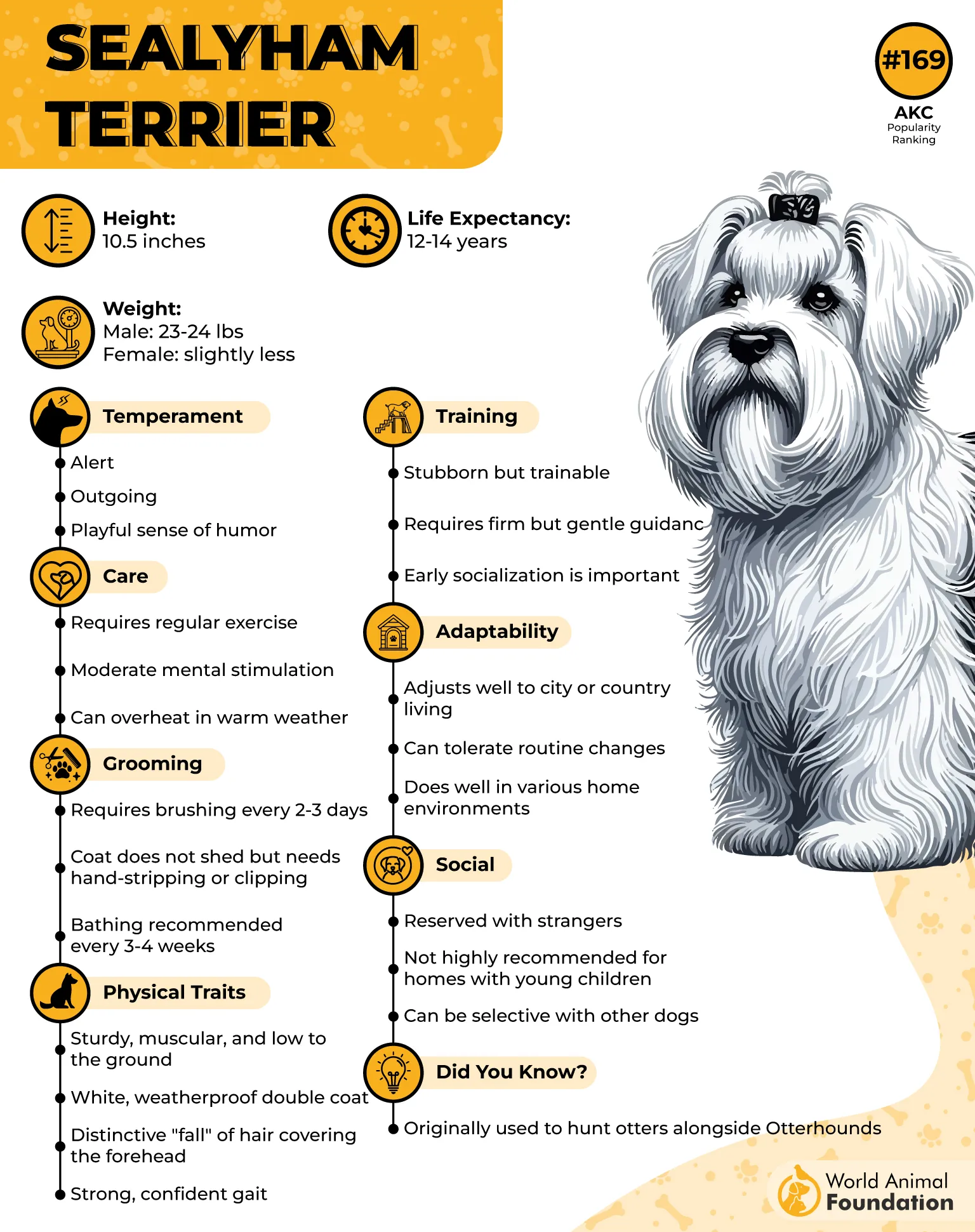
Sealyhams are loyal to their family but tend to be independent thinkers. They can be stubborn during training, so patience and positive reinforcement are essential. When socialized properly, they’re good with other pets and enjoy quiet interaction over chaos.
Their white, weather-resistant coat needs consistent care. Brushing two to three times per week helps manage shedding and keeps the wiry outer coat healthy. Hand-stripping preserves the coat’s texture, but clipping is a practical option for most pet homes.
Sealyhams are among the more composed terriers, combining vintage style with steady companionship—a breed both charming and rare.
Quick Tips
Best suited for owners willing to commit to regular coat care
Responds well to calm, reward-based training
Prefers a peaceful home over high-energy play spaces
Conclusion
While cartoonish in appearance, these rare breeds are anything but ordinary. From the lamb-like Bedlington Terrier to the plush and expressive Keeshond, each of these dogs offers a combination of charm, individuality, and a touch of whimsy that sets them apart from more common breeds.
They may share traits with more familiar companions, but their unique histories, grooming needs, and personalities make them fascinating pets for owners seeking something truly different. These dogs don’t just look animated, they often act the part, too, with expressive faces, bold postures, and love for human attention.
Whether you’re drawn to their teddy bear-like fluff, lion-trimmed elegance, or big-eyed intensity, these rare dogs are a reminder that the world of canines is vast and wonderfully diverse. Owning one may not be as simple as adopting a related or popular breed, but the payoff is a truly one-of-a-kind companion.
If you’re looking for a pet with both style and soul, one of these rarities might be the perfect fit.


